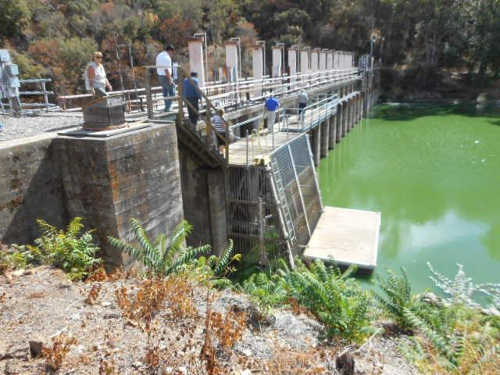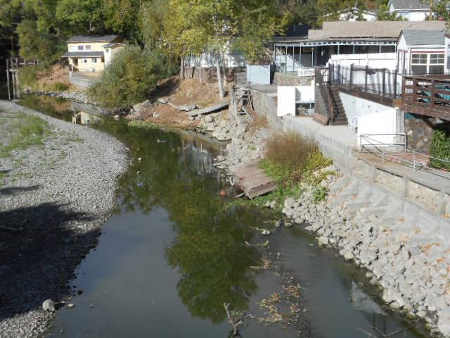
LOWER LAKE, Calif. – A group of 14 Realtors and staff from CPS Country Air Properties took a tour of the Grigsby Riffle and the Cache Creek dam on Wednesday, Sept. 24.
They were met by Tim O'Halloran, general manager of the Yolo County Flood Control & Water Conservation District, who conducted the tour.
The group met at the Grigsby Riffle, a rock ledge that crosses Cache Creek near the Lake Street Bridge in Lower Lake, approximately one and a half miles from Clear Lake.
The riffle is at a narrow point in the creek and limits the amount of water which may flow past it, acting as a natural dam. Thus, the riffle controls outflow from Clear Lake. The riffle maintained lake levels prior to the construction of the Cache Creek Dam in 1914.
Most of the group made their way onto the riffle, which is currently exposed due to the low lake level, though covered by a gravel bar.
Access to the riffle is rare, since the lake rarely gets low enough to expose it. In fact, the riffle is the most exposed that it has been since 1977, when the lake level dropped to -3.39 on the Rumsey Scale.
O’Halloran explained how the Rumsey Scale was developed.
“In 1872, Captain Rumsey was authorized to come up with a way to measure Clear Lake’s level,” according to O’Halloran. “Rumsey determined that when water stopped flowing over the riffle it would be called “Zero Rumsey.”
When water was above the riffle it would be called plus Rumsey, such as 1 foot, 2 feet and so on. Below the riffle, the lake level would be measured as a minus on the Rumsey Gauge.
All measurements were based on zero Rumsey at the Grigsby Riffle. However, the actual gauge is located in Lakeport and it's used as a reference to the actual depth at the riffle, not the depth at Lakeport.”
Today, a channel runs through the riffle, so even though the lake level is below zero, water is still coming out of the lake.
“It is unclear whether the channel is man-made or a natural occurrence,” according to Phil Smoley, tour coordinator. “But even though the lake level is below zero, people are still kayaking through the riffle, so a lot of water is still draining out of the lake.”
O'Halloran then led the group about four miles to the Cache Creek Dam, built 100 years ago in 1914.
O'Halloran explained that the dam can artificially keep the lake level up above zero Rumsey, which he explained is a win-win for both Yolo and Lake counties.

“Lake County wants to keep the water level up for summer recreation, while Yolo wants to preserve water for later agricultural use,” he explained. “But there is a natural tension between the two regions due to their conflicting needs. When Yolo needs water in the summer, Lake County needs it to keep its lake level up for recreation. When Yolo wants to store water and prevent down stream flooding, Lake County wants to release water to prevent Clear Lake from flooding.”
It was these conflicting needs that ended up in court on multiple occasions, leading to the Gopjevik Decree (1920) , the Bemerly Decree (1940), and the Solano Decree (1970). It is these decrees that dictate how much water can be released and when it can be released.
“People often get mad at me and the Flood District for either letting out too much water or not enough, but it’s not our call. We are required to follow the decrees and have little to no discretion regarding what is done at the dam,” O'Halloran explained. “If someone does not like what is happening, they need to get the decrees modified or replaced; we can’t diverge from them in any way.”
While still an area of contention, the decrees have generally served both counties well. “My take away was that there were some very wise, reasonable people who did a great job in balancing the various needs of both regions by means of these decrees,” Smoley noted. “Other than some possible fine tunes that might be needed here and there, they seem to work out remarkably well in spite of the variations in weather and rainfall.”
In spite of being 100 years old, the dam appears to be in remarkably good condition, other than slightly leaking gates.
“We are leaving those alone for now since Fish and Game prefer that some water be released downstream for the benefit of wildlife, and the small amount leaking through is sufficient for that purpose,” O'Halloran said.
Smoley’s group was impressed by the tour.
“Clear Lake is a remarkable natural treasure with so many fascinating aspects. Learning about the riffle and dam filled in a lot of blanks for us and put a lot of myths to bed. I think we are all better informed to explain important issues about our lake to future buyers of lake front properties,” Smoley stated.









